Leadership and Management Analysis for Complete IT Business
VerifiedAdded on 2020/10/22
|9
|2643
|197
Report
AI Summary
This report delves into the functional areas and management hierarchy of Complete IT, an IT solutions company. It examines key aspects of leadership and management communication, emphasizing its importance for effective organizational function and employee engagement. The report also analyzes current drivers of globalization, such as technological advancements, trade liberalization, and increased competition, and their impact on businesses like Tesco. Furthermore, it compares and contrasts democratic and autocratic leadership styles, concluding that democratic leadership is more suitable for the modern globalized business environment due to its collaborative approach and ability to foster innovation and strong team relationships. The report provides insights into how these concepts can be applied to enhance business performance and adapt to global challenges.

BUSINESS.
Paraphrase This Document
Need a fresh take? Get an instant paraphrase of this document with our AI Paraphraser
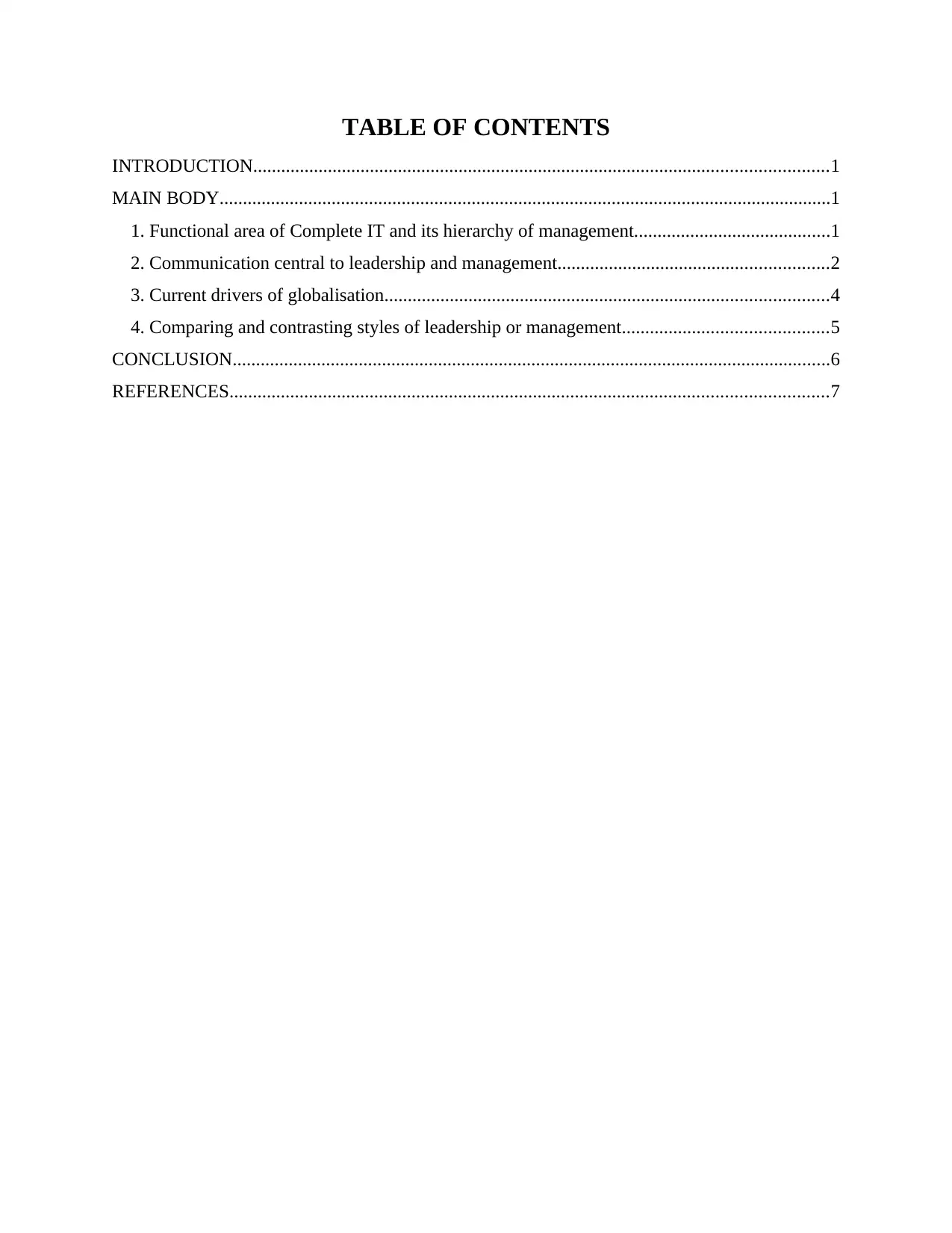
TABLE OF CONTENTS
INTRODUCTION...........................................................................................................................1
MAIN BODY...................................................................................................................................1
1. Functional area of Complete IT and its hierarchy of management..........................................1
2. Communication central to leadership and management..........................................................2
3. Current drivers of globalisation...............................................................................................4
4. Comparing and contrasting styles of leadership or management............................................5
CONCLUSION................................................................................................................................6
REFERENCES................................................................................................................................7
INTRODUCTION...........................................................................................................................1
MAIN BODY...................................................................................................................................1
1. Functional area of Complete IT and its hierarchy of management..........................................1
2. Communication central to leadership and management..........................................................2
3. Current drivers of globalisation...............................................................................................4
4. Comparing and contrasting styles of leadership or management............................................5
CONCLUSION................................................................................................................................6
REFERENCES................................................................................................................................7
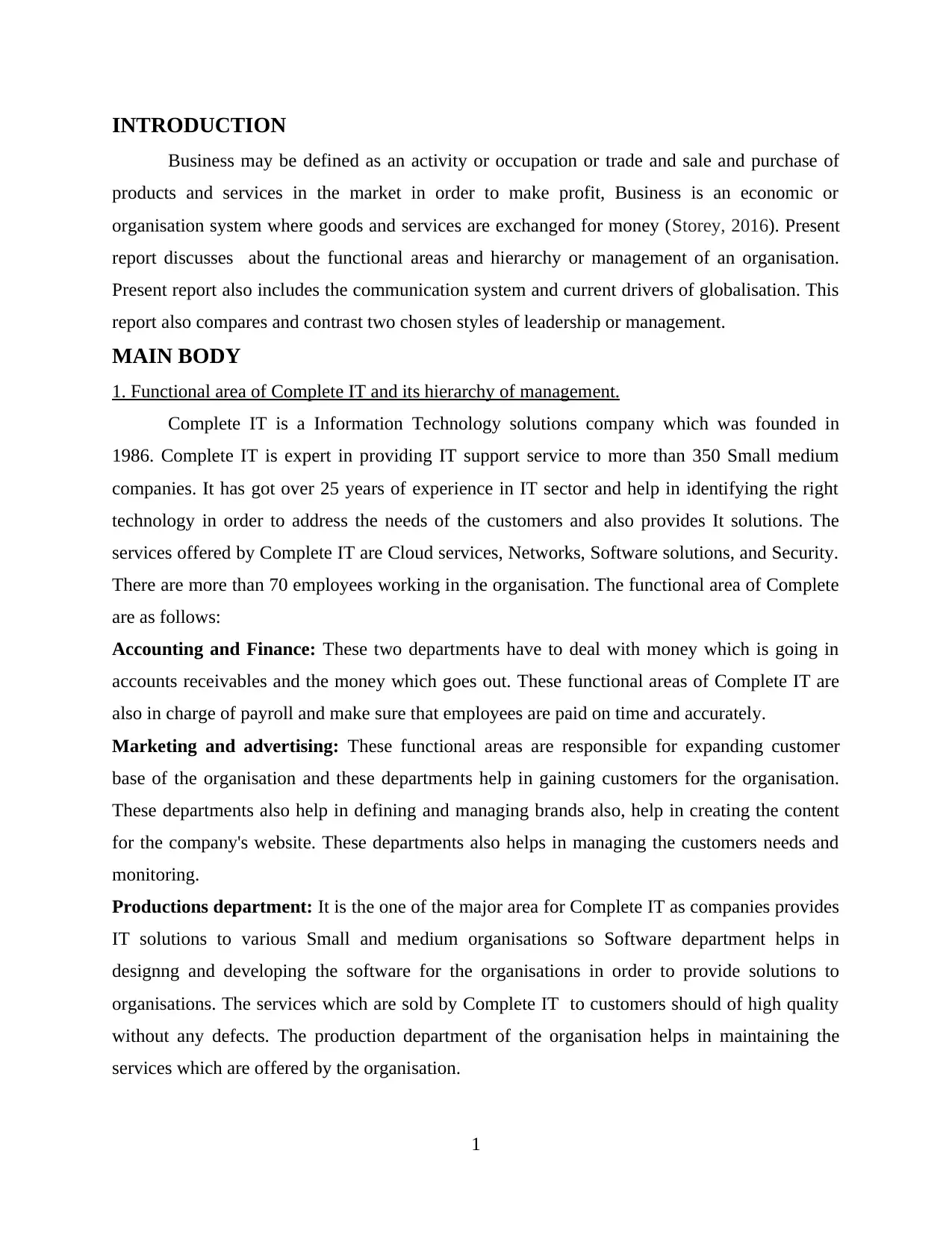
INTRODUCTION
Business may be defined as an activity or occupation or trade and sale and purchase of
products and services in the market in order to make profit, Business is an economic or
organisation system where goods and services are exchanged for money (Storey, 2016). Present
report discusses about the functional areas and hierarchy or management of an organisation.
Present report also includes the communication system and current drivers of globalisation. This
report also compares and contrast two chosen styles of leadership or management.
MAIN BODY
1. Functional area of Complete IT and its hierarchy of management.
Complete IT is a Information Technology solutions company which was founded in
1986. Complete IT is expert in providing IT support service to more than 350 Small medium
companies. It has got over 25 years of experience in IT sector and help in identifying the right
technology in order to address the needs of the customers and also provides It solutions. The
services offered by Complete IT are Cloud services, Networks, Software solutions, and Security.
There are more than 70 employees working in the organisation. The functional area of Complete
are as follows:
Accounting and Finance: These two departments have to deal with money which is going in
accounts receivables and the money which goes out. These functional areas of Complete IT are
also in charge of payroll and make sure that employees are paid on time and accurately.
Marketing and advertising: These functional areas are responsible for expanding customer
base of the organisation and these departments help in gaining customers for the organisation.
These departments also help in defining and managing brands also, help in creating the content
for the company's website. These departments also helps in managing the customers needs and
monitoring.
Productions department: It is the one of the major area for Complete IT as companies provides
IT solutions to various Small and medium organisations so Software department helps in
designng and developing the software for the organisations in order to provide solutions to
organisations. The services which are sold by Complete IT to customers should of high quality
without any defects. The production department of the organisation helps in maintaining the
services which are offered by the organisation.
1
Business may be defined as an activity or occupation or trade and sale and purchase of
products and services in the market in order to make profit, Business is an economic or
organisation system where goods and services are exchanged for money (Storey, 2016). Present
report discusses about the functional areas and hierarchy or management of an organisation.
Present report also includes the communication system and current drivers of globalisation. This
report also compares and contrast two chosen styles of leadership or management.
MAIN BODY
1. Functional area of Complete IT and its hierarchy of management.
Complete IT is a Information Technology solutions company which was founded in
1986. Complete IT is expert in providing IT support service to more than 350 Small medium
companies. It has got over 25 years of experience in IT sector and help in identifying the right
technology in order to address the needs of the customers and also provides It solutions. The
services offered by Complete IT are Cloud services, Networks, Software solutions, and Security.
There are more than 70 employees working in the organisation. The functional area of Complete
are as follows:
Accounting and Finance: These two departments have to deal with money which is going in
accounts receivables and the money which goes out. These functional areas of Complete IT are
also in charge of payroll and make sure that employees are paid on time and accurately.
Marketing and advertising: These functional areas are responsible for expanding customer
base of the organisation and these departments help in gaining customers for the organisation.
These departments also help in defining and managing brands also, help in creating the content
for the company's website. These departments also helps in managing the customers needs and
monitoring.
Productions department: It is the one of the major area for Complete IT as companies provides
IT solutions to various Small and medium organisations so Software department helps in
designng and developing the software for the organisations in order to provide solutions to
organisations. The services which are sold by Complete IT to customers should of high quality
without any defects. The production department of the organisation helps in maintaining the
services which are offered by the organisation.
1
⊘ This is a preview!⊘
Do you want full access?
Subscribe today to unlock all pages.

Trusted by 1+ million students worldwide
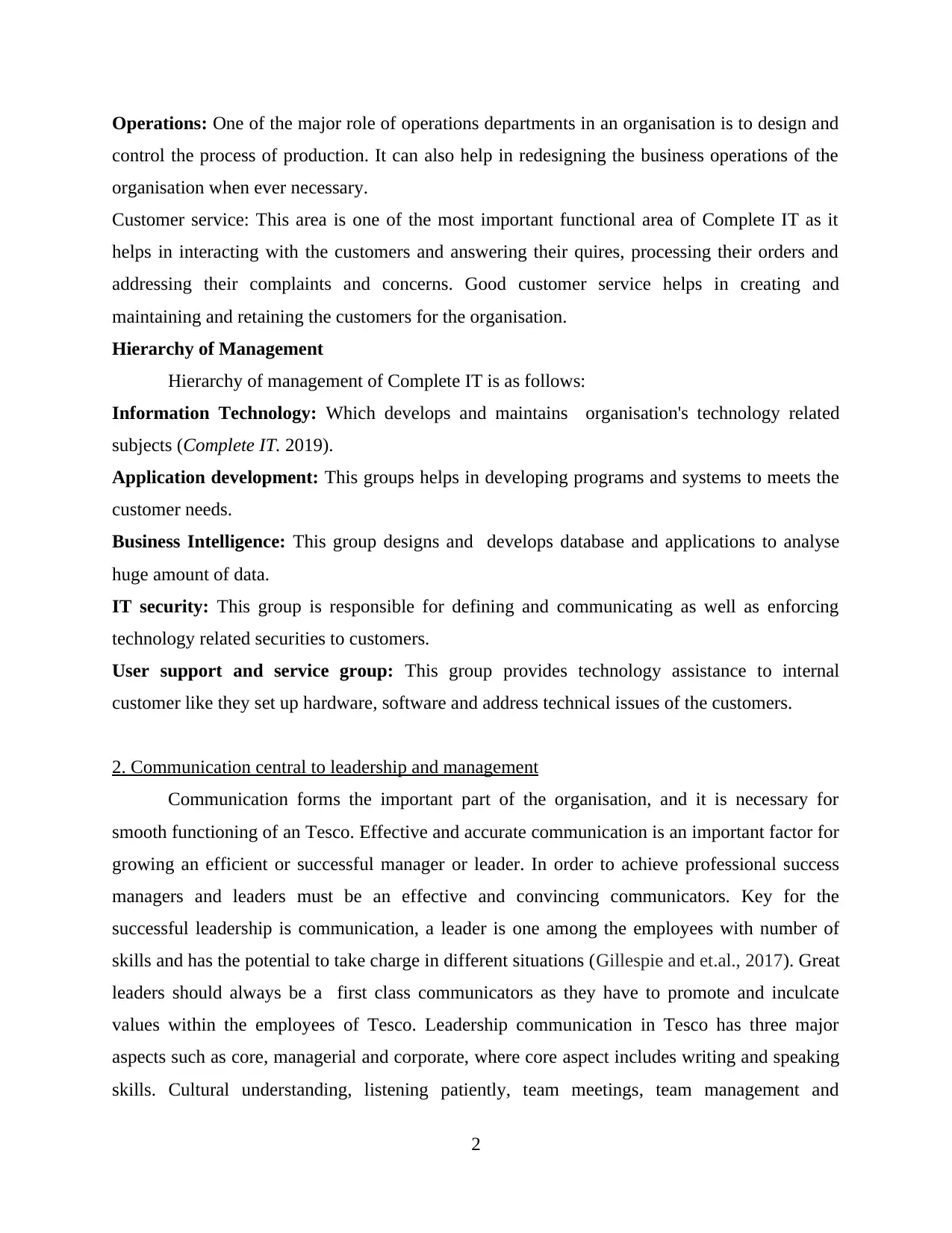
Operations: One of the major role of operations departments in an organisation is to design and
control the process of production. It can also help in redesigning the business operations of the
organisation when ever necessary.
Customer service: This area is one of the most important functional area of Complete IT as it
helps in interacting with the customers and answering their quires, processing their orders and
addressing their complaints and concerns. Good customer service helps in creating and
maintaining and retaining the customers for the organisation.
Hierarchy of Management
Hierarchy of management of Complete IT is as follows:
Information Technology: Which develops and maintains organisation's technology related
subjects (Complete IT. 2019).
Application development: This groups helps in developing programs and systems to meets the
customer needs.
Business Intelligence: This group designs and develops database and applications to analyse
huge amount of data.
IT security: This group is responsible for defining and communicating as well as enforcing
technology related securities to customers.
User support and service group: This group provides technology assistance to internal
customer like they set up hardware, software and address technical issues of the customers.
2. Communication central to leadership and management
Communication forms the important part of the organisation, and it is necessary for
smooth functioning of an Tesco. Effective and accurate communication is an important factor for
growing an efficient or successful manager or leader. In order to achieve professional success
managers and leaders must be an effective and convincing communicators. Key for the
successful leadership is communication, a leader is one among the employees with number of
skills and has the potential to take charge in different situations (Gillespie and et.al., 2017). Great
leaders should always be a first class communicators as they have to promote and inculcate
values within the employees of Tesco. Leadership communication in Tesco has three major
aspects such as core, managerial and corporate, where core aspect includes writing and speaking
skills. Cultural understanding, listening patiently, team meetings, team management and
2
control the process of production. It can also help in redesigning the business operations of the
organisation when ever necessary.
Customer service: This area is one of the most important functional area of Complete IT as it
helps in interacting with the customers and answering their quires, processing their orders and
addressing their complaints and concerns. Good customer service helps in creating and
maintaining and retaining the customers for the organisation.
Hierarchy of Management
Hierarchy of management of Complete IT is as follows:
Information Technology: Which develops and maintains organisation's technology related
subjects (Complete IT. 2019).
Application development: This groups helps in developing programs and systems to meets the
customer needs.
Business Intelligence: This group designs and develops database and applications to analyse
huge amount of data.
IT security: This group is responsible for defining and communicating as well as enforcing
technology related securities to customers.
User support and service group: This group provides technology assistance to internal
customer like they set up hardware, software and address technical issues of the customers.
2. Communication central to leadership and management
Communication forms the important part of the organisation, and it is necessary for
smooth functioning of an Tesco. Effective and accurate communication is an important factor for
growing an efficient or successful manager or leader. In order to achieve professional success
managers and leaders must be an effective and convincing communicators. Key for the
successful leadership is communication, a leader is one among the employees with number of
skills and has the potential to take charge in different situations (Gillespie and et.al., 2017). Great
leaders should always be a first class communicators as they have to promote and inculcate
values within the employees of Tesco. Leadership communication in Tesco has three major
aspects such as core, managerial and corporate, where core aspect includes writing and speaking
skills. Cultural understanding, listening patiently, team meetings, team management and
2
Paraphrase This Document
Need a fresh take? Get an instant paraphrase of this document with our AI Paraphraser
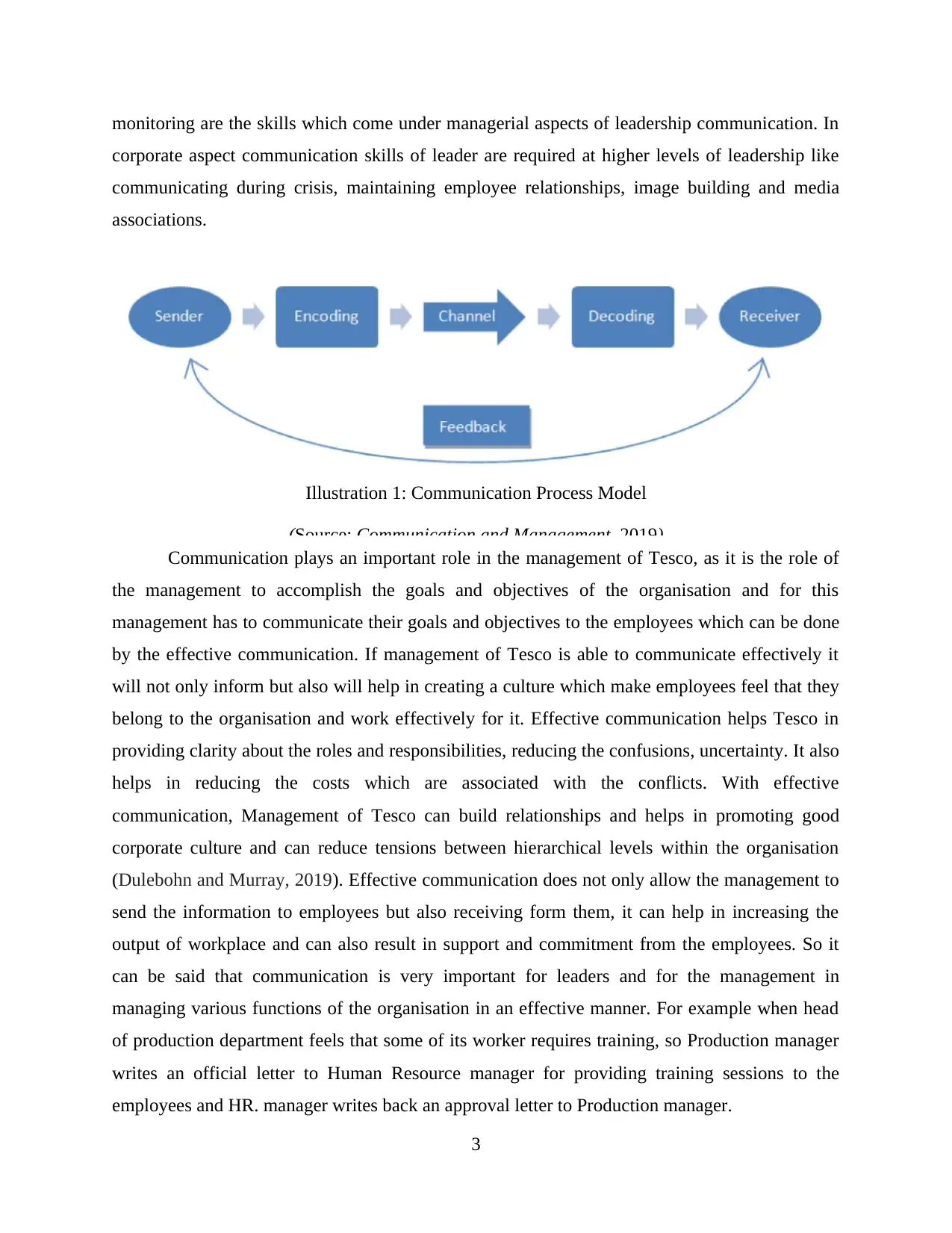
monitoring are the skills which come under managerial aspects of leadership communication. In
corporate aspect communication skills of leader are required at higher levels of leadership like
communicating during crisis, maintaining employee relationships, image building and media
associations.
Illustration 1: Communication Process Model
(Source: Communication and Management, 2019)
Communication plays an important role in the management of Tesco, as it is the role of
the management to accomplish the goals and objectives of the organisation and for this
management has to communicate their goals and objectives to the employees which can be done
by the effective communication. If management of Tesco is able to communicate effectively it
will not only inform but also will help in creating a culture which make employees feel that they
belong to the organisation and work effectively for it. Effective communication helps Tesco in
providing clarity about the roles and responsibilities, reducing the confusions, uncertainty. It also
helps in reducing the costs which are associated with the conflicts. With effective
communication, Management of Tesco can build relationships and helps in promoting good
corporate culture and can reduce tensions between hierarchical levels within the organisation
(Dulebohn and Murray, 2019). Effective communication does not only allow the management to
send the information to employees but also receiving form them, it can help in increasing the
output of workplace and can also result in support and commitment from the employees. So it
can be said that communication is very important for leaders and for the management in
managing various functions of the organisation in an effective manner. For example when head
of production department feels that some of its worker requires training, so Production manager
writes an official letter to Human Resource manager for providing training sessions to the
employees and HR. manager writes back an approval letter to Production manager.
3
corporate aspect communication skills of leader are required at higher levels of leadership like
communicating during crisis, maintaining employee relationships, image building and media
associations.
Illustration 1: Communication Process Model
(Source: Communication and Management, 2019)
Communication plays an important role in the management of Tesco, as it is the role of
the management to accomplish the goals and objectives of the organisation and for this
management has to communicate their goals and objectives to the employees which can be done
by the effective communication. If management of Tesco is able to communicate effectively it
will not only inform but also will help in creating a culture which make employees feel that they
belong to the organisation and work effectively for it. Effective communication helps Tesco in
providing clarity about the roles and responsibilities, reducing the confusions, uncertainty. It also
helps in reducing the costs which are associated with the conflicts. With effective
communication, Management of Tesco can build relationships and helps in promoting good
corporate culture and can reduce tensions between hierarchical levels within the organisation
(Dulebohn and Murray, 2019). Effective communication does not only allow the management to
send the information to employees but also receiving form them, it can help in increasing the
output of workplace and can also result in support and commitment from the employees. So it
can be said that communication is very important for leaders and for the management in
managing various functions of the organisation in an effective manner. For example when head
of production department feels that some of its worker requires training, so Production manager
writes an official letter to Human Resource manager for providing training sessions to the
employees and HR. manager writes back an approval letter to Production manager.
3
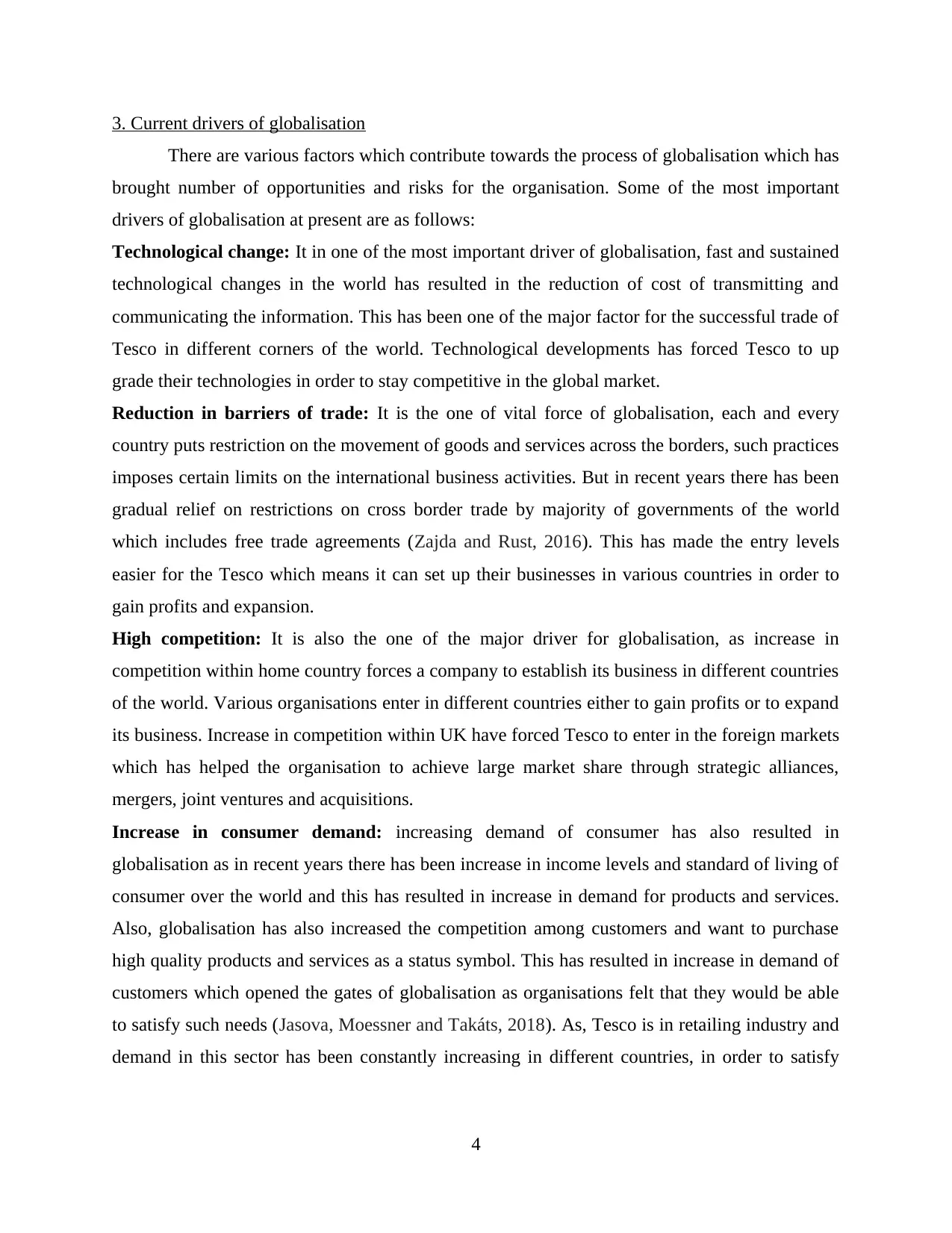
3. Current drivers of globalisation
There are various factors which contribute towards the process of globalisation which has
brought number of opportunities and risks for the organisation. Some of the most important
drivers of globalisation at present are as follows:
Technological change: It in one of the most important driver of globalisation, fast and sustained
technological changes in the world has resulted in the reduction of cost of transmitting and
communicating the information. This has been one of the major factor for the successful trade of
Tesco in different corners of the world. Technological developments has forced Tesco to up
grade their technologies in order to stay competitive in the global market.
Reduction in barriers of trade: It is the one of vital force of globalisation, each and every
country puts restriction on the movement of goods and services across the borders, such practices
imposes certain limits on the international business activities. But in recent years there has been
gradual relief on restrictions on cross border trade by majority of governments of the world
which includes free trade agreements (Zajda and Rust, 2016). This has made the entry levels
easier for the Tesco which means it can set up their businesses in various countries in order to
gain profits and expansion.
High competition: It is also the one of the major driver for globalisation, as increase in
competition within home country forces a company to establish its business in different countries
of the world. Various organisations enter in different countries either to gain profits or to expand
its business. Increase in competition within UK have forced Tesco to enter in the foreign markets
which has helped the organisation to achieve large market share through strategic alliances,
mergers, joint ventures and acquisitions.
Increase in consumer demand: increasing demand of consumer has also resulted in
globalisation as in recent years there has been increase in income levels and standard of living of
consumer over the world and this has resulted in increase in demand for products and services.
Also, globalisation has also increased the competition among customers and want to purchase
high quality products and services as a status symbol. This has resulted in increase in demand of
customers which opened the gates of globalisation as organisations felt that they would be able
to satisfy such needs (Jasova, Moessner and Takáts, 2018). As, Tesco is in retailing industry and
demand in this sector has been constantly increasing in different countries, in order to satisfy
4
There are various factors which contribute towards the process of globalisation which has
brought number of opportunities and risks for the organisation. Some of the most important
drivers of globalisation at present are as follows:
Technological change: It in one of the most important driver of globalisation, fast and sustained
technological changes in the world has resulted in the reduction of cost of transmitting and
communicating the information. This has been one of the major factor for the successful trade of
Tesco in different corners of the world. Technological developments has forced Tesco to up
grade their technologies in order to stay competitive in the global market.
Reduction in barriers of trade: It is the one of vital force of globalisation, each and every
country puts restriction on the movement of goods and services across the borders, such practices
imposes certain limits on the international business activities. But in recent years there has been
gradual relief on restrictions on cross border trade by majority of governments of the world
which includes free trade agreements (Zajda and Rust, 2016). This has made the entry levels
easier for the Tesco which means it can set up their businesses in various countries in order to
gain profits and expansion.
High competition: It is also the one of the major driver for globalisation, as increase in
competition within home country forces a company to establish its business in different countries
of the world. Various organisations enter in different countries either to gain profits or to expand
its business. Increase in competition within UK have forced Tesco to enter in the foreign markets
which has helped the organisation to achieve large market share through strategic alliances,
mergers, joint ventures and acquisitions.
Increase in consumer demand: increasing demand of consumer has also resulted in
globalisation as in recent years there has been increase in income levels and standard of living of
consumer over the world and this has resulted in increase in demand for products and services.
Also, globalisation has also increased the competition among customers and want to purchase
high quality products and services as a status symbol. This has resulted in increase in demand of
customers which opened the gates of globalisation as organisations felt that they would be able
to satisfy such needs (Jasova, Moessner and Takáts, 2018). As, Tesco is in retailing industry and
demand in this sector has been constantly increasing in different countries, in order to satisfy
4
⊘ This is a preview!⊘
Do you want full access?
Subscribe today to unlock all pages.

Trusted by 1+ million students worldwide
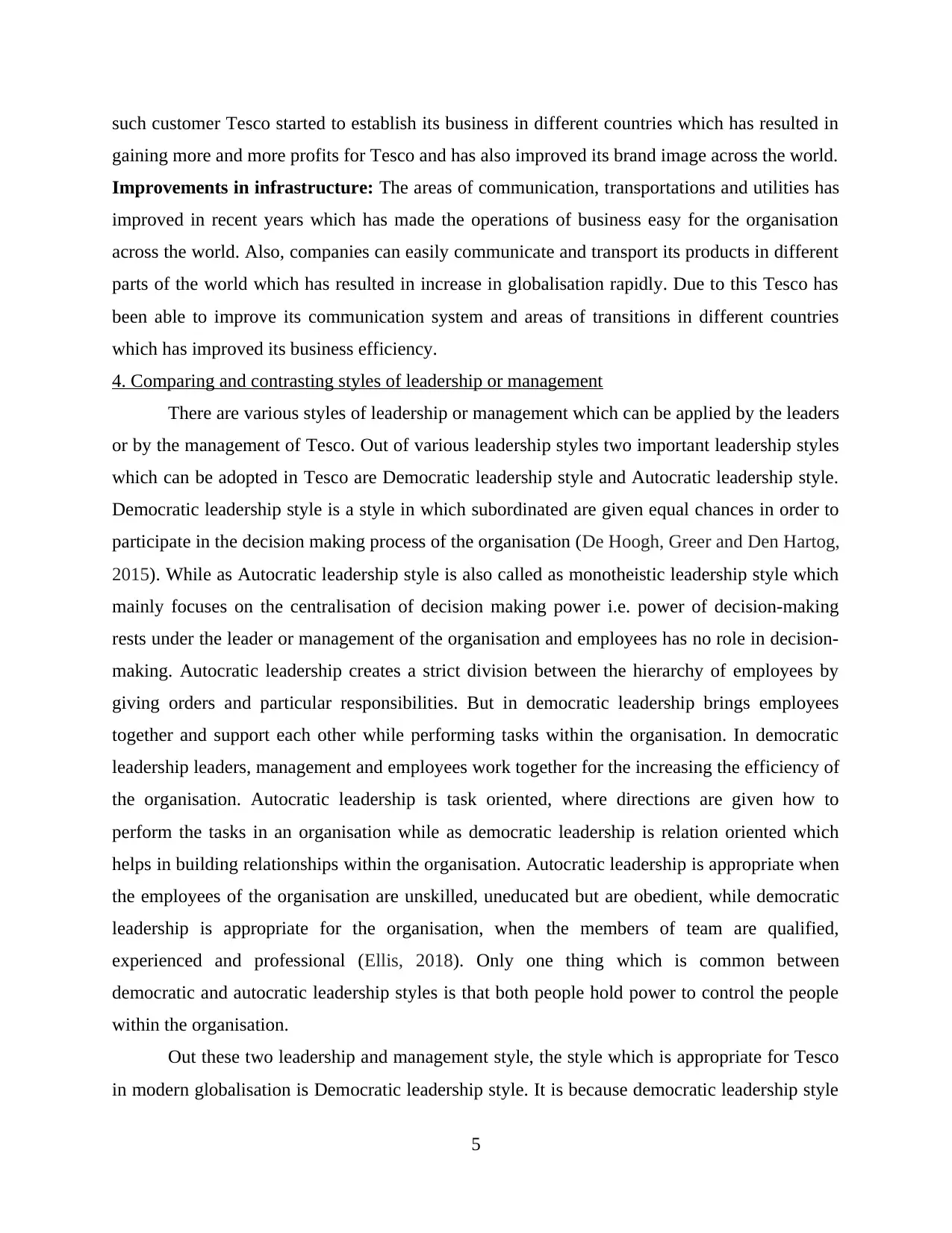
such customer Tesco started to establish its business in different countries which has resulted in
gaining more and more profits for Tesco and has also improved its brand image across the world.
Improvements in infrastructure: The areas of communication, transportations and utilities has
improved in recent years which has made the operations of business easy for the organisation
across the world. Also, companies can easily communicate and transport its products in different
parts of the world which has resulted in increase in globalisation rapidly. Due to this Tesco has
been able to improve its communication system and areas of transitions in different countries
which has improved its business efficiency.
4. Comparing and contrasting styles of leadership or management
There are various styles of leadership or management which can be applied by the leaders
or by the management of Tesco. Out of various leadership styles two important leadership styles
which can be adopted in Tesco are Democratic leadership style and Autocratic leadership style.
Democratic leadership style is a style in which subordinated are given equal chances in order to
participate in the decision making process of the organisation (De Hoogh, Greer and Den Hartog,
2015). While as Autocratic leadership style is also called as monotheistic leadership style which
mainly focuses on the centralisation of decision making power i.e. power of decision-making
rests under the leader or management of the organisation and employees has no role in decision-
making. Autocratic leadership creates a strict division between the hierarchy of employees by
giving orders and particular responsibilities. But in democratic leadership brings employees
together and support each other while performing tasks within the organisation. In democratic
leadership leaders, management and employees work together for the increasing the efficiency of
the organisation. Autocratic leadership is task oriented, where directions are given how to
perform the tasks in an organisation while as democratic leadership is relation oriented which
helps in building relationships within the organisation. Autocratic leadership is appropriate when
the employees of the organisation are unskilled, uneducated but are obedient, while democratic
leadership is appropriate for the organisation, when the members of team are qualified,
experienced and professional (Ellis, 2018). Only one thing which is common between
democratic and autocratic leadership styles is that both people hold power to control the people
within the organisation.
Out these two leadership and management style, the style which is appropriate for Tesco
in modern globalisation is Democratic leadership style. It is because democratic leadership style
5
gaining more and more profits for Tesco and has also improved its brand image across the world.
Improvements in infrastructure: The areas of communication, transportations and utilities has
improved in recent years which has made the operations of business easy for the organisation
across the world. Also, companies can easily communicate and transport its products in different
parts of the world which has resulted in increase in globalisation rapidly. Due to this Tesco has
been able to improve its communication system and areas of transitions in different countries
which has improved its business efficiency.
4. Comparing and contrasting styles of leadership or management
There are various styles of leadership or management which can be applied by the leaders
or by the management of Tesco. Out of various leadership styles two important leadership styles
which can be adopted in Tesco are Democratic leadership style and Autocratic leadership style.
Democratic leadership style is a style in which subordinated are given equal chances in order to
participate in the decision making process of the organisation (De Hoogh, Greer and Den Hartog,
2015). While as Autocratic leadership style is also called as monotheistic leadership style which
mainly focuses on the centralisation of decision making power i.e. power of decision-making
rests under the leader or management of the organisation and employees has no role in decision-
making. Autocratic leadership creates a strict division between the hierarchy of employees by
giving orders and particular responsibilities. But in democratic leadership brings employees
together and support each other while performing tasks within the organisation. In democratic
leadership leaders, management and employees work together for the increasing the efficiency of
the organisation. Autocratic leadership is task oriented, where directions are given how to
perform the tasks in an organisation while as democratic leadership is relation oriented which
helps in building relationships within the organisation. Autocratic leadership is appropriate when
the employees of the organisation are unskilled, uneducated but are obedient, while democratic
leadership is appropriate for the organisation, when the members of team are qualified,
experienced and professional (Ellis, 2018). Only one thing which is common between
democratic and autocratic leadership styles is that both people hold power to control the people
within the organisation.
Out these two leadership and management style, the style which is appropriate for Tesco
in modern globalisation is Democratic leadership style. It is because democratic leadership style
5
Paraphrase This Document
Need a fresh take? Get an instant paraphrase of this document with our AI Paraphraser
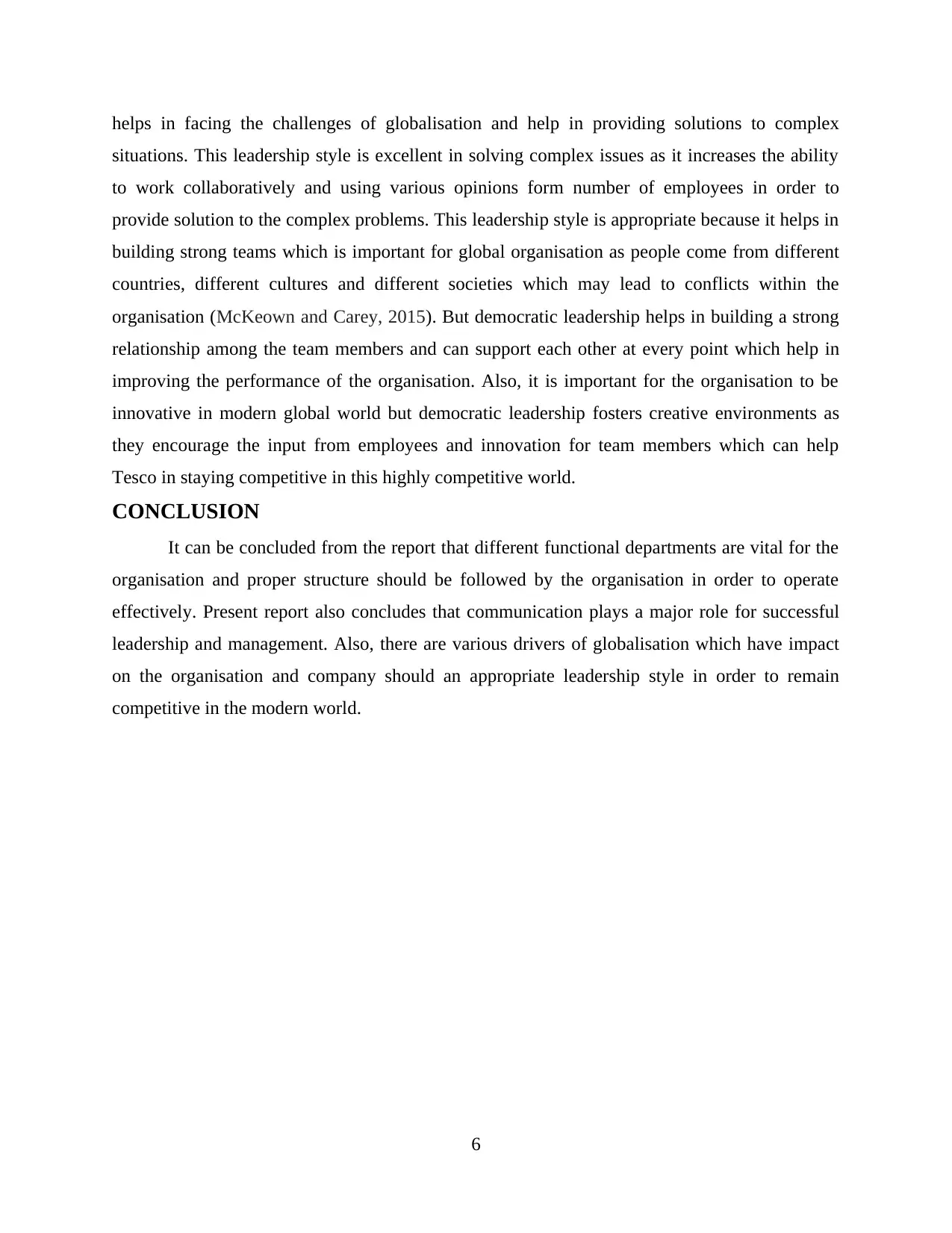
helps in facing the challenges of globalisation and help in providing solutions to complex
situations. This leadership style is excellent in solving complex issues as it increases the ability
to work collaboratively and using various opinions form number of employees in order to
provide solution to the complex problems. This leadership style is appropriate because it helps in
building strong teams which is important for global organisation as people come from different
countries, different cultures and different societies which may lead to conflicts within the
organisation (McKeown and Carey, 2015). But democratic leadership helps in building a strong
relationship among the team members and can support each other at every point which help in
improving the performance of the organisation. Also, it is important for the organisation to be
innovative in modern global world but democratic leadership fosters creative environments as
they encourage the input from employees and innovation for team members which can help
Tesco in staying competitive in this highly competitive world.
CONCLUSION
It can be concluded from the report that different functional departments are vital for the
organisation and proper structure should be followed by the organisation in order to operate
effectively. Present report also concludes that communication plays a major role for successful
leadership and management. Also, there are various drivers of globalisation which have impact
on the organisation and company should an appropriate leadership style in order to remain
competitive in the modern world.
6
situations. This leadership style is excellent in solving complex issues as it increases the ability
to work collaboratively and using various opinions form number of employees in order to
provide solution to the complex problems. This leadership style is appropriate because it helps in
building strong teams which is important for global organisation as people come from different
countries, different cultures and different societies which may lead to conflicts within the
organisation (McKeown and Carey, 2015). But democratic leadership helps in building a strong
relationship among the team members and can support each other at every point which help in
improving the performance of the organisation. Also, it is important for the organisation to be
innovative in modern global world but democratic leadership fosters creative environments as
they encourage the input from employees and innovation for team members which can help
Tesco in staying competitive in this highly competitive world.
CONCLUSION
It can be concluded from the report that different functional departments are vital for the
organisation and proper structure should be followed by the organisation in order to operate
effectively. Present report also concludes that communication plays a major role for successful
leadership and management. Also, there are various drivers of globalisation which have impact
on the organisation and company should an appropriate leadership style in order to remain
competitive in the modern world.
6
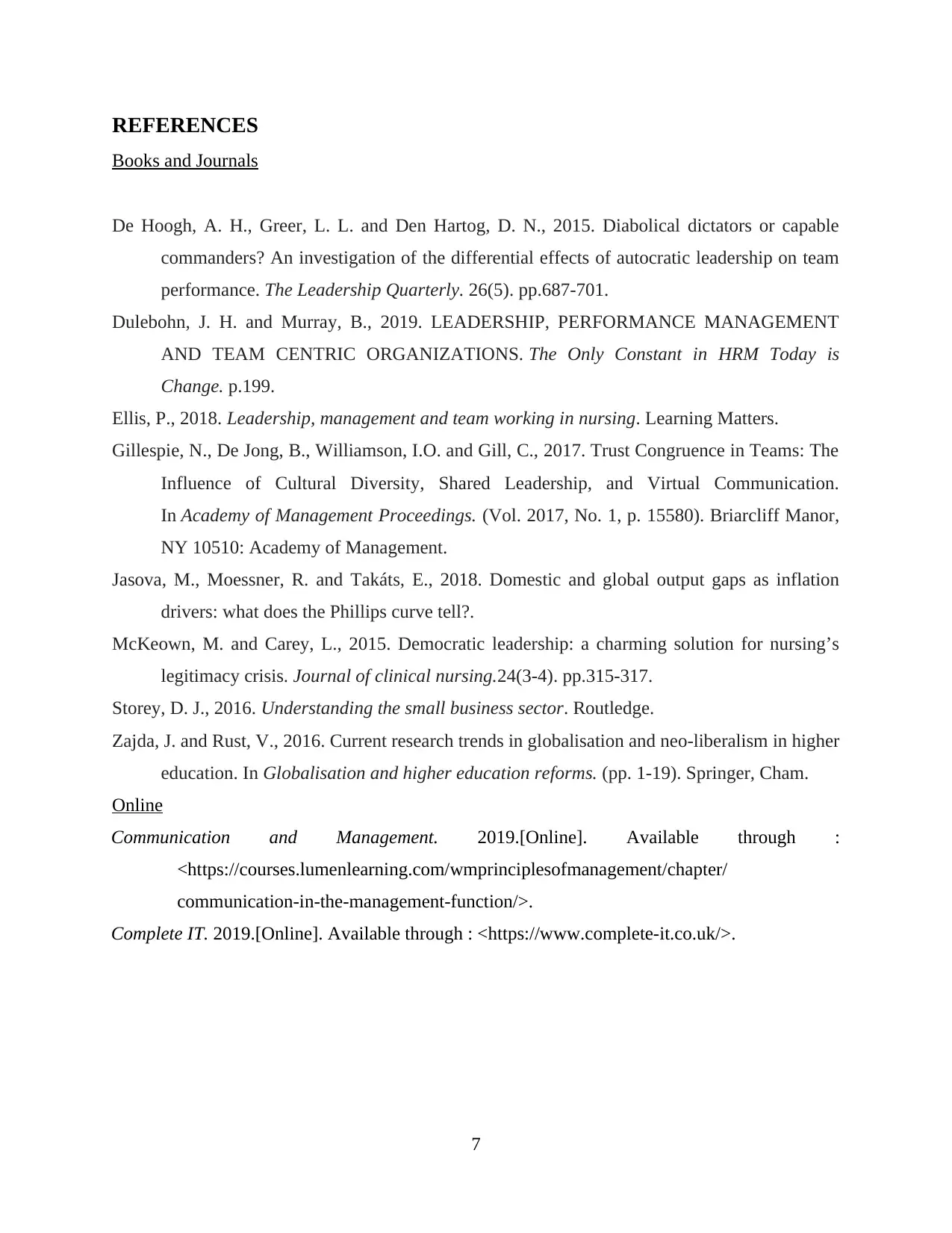
REFERENCES
Books and Journals
De Hoogh, A. H., Greer, L. L. and Den Hartog, D. N., 2015. Diabolical dictators or capable
commanders? An investigation of the differential effects of autocratic leadership on team
performance. The Leadership Quarterly. 26(5). pp.687-701.
Dulebohn, J. H. and Murray, B., 2019. LEADERSHIP, PERFORMANCE MANAGEMENT
AND TEAM CENTRIC ORGANIZATIONS. The Only Constant in HRM Today is
Change. p.199.
Ellis, P., 2018. Leadership, management and team working in nursing. Learning Matters.
Gillespie, N., De Jong, B., Williamson, I.O. and Gill, C., 2017. Trust Congruence in Teams: The
Influence of Cultural Diversity, Shared Leadership, and Virtual Communication.
In Academy of Management Proceedings. (Vol. 2017, No. 1, p. 15580). Briarcliff Manor,
NY 10510: Academy of Management.
Jasova, M., Moessner, R. and Takáts, E., 2018. Domestic and global output gaps as inflation
drivers: what does the Phillips curve tell?.
McKeown, M. and Carey, L., 2015. Democratic leadership: a charming solution for nursing’s
legitimacy crisis. Journal of clinical nursing.24(3-4). pp.315-317.
Storey, D. J., 2016. Understanding the small business sector. Routledge.
Zajda, J. and Rust, V., 2016. Current research trends in globalisation and neo-liberalism in higher
education. In Globalisation and higher education reforms. (pp. 1-19). Springer, Cham.
Online
Communication and Management. 2019.[Online]. Available through :
<https://courses.lumenlearning.com/wmprinciplesofmanagement/chapter/
communication-in-the-management-function/>.
Complete IT. 2019.[Online]. Available through : <https://www.complete-it.co.uk/>.
7
Books and Journals
De Hoogh, A. H., Greer, L. L. and Den Hartog, D. N., 2015. Diabolical dictators or capable
commanders? An investigation of the differential effects of autocratic leadership on team
performance. The Leadership Quarterly. 26(5). pp.687-701.
Dulebohn, J. H. and Murray, B., 2019. LEADERSHIP, PERFORMANCE MANAGEMENT
AND TEAM CENTRIC ORGANIZATIONS. The Only Constant in HRM Today is
Change. p.199.
Ellis, P., 2018. Leadership, management and team working in nursing. Learning Matters.
Gillespie, N., De Jong, B., Williamson, I.O. and Gill, C., 2017. Trust Congruence in Teams: The
Influence of Cultural Diversity, Shared Leadership, and Virtual Communication.
In Academy of Management Proceedings. (Vol. 2017, No. 1, p. 15580). Briarcliff Manor,
NY 10510: Academy of Management.
Jasova, M., Moessner, R. and Takáts, E., 2018. Domestic and global output gaps as inflation
drivers: what does the Phillips curve tell?.
McKeown, M. and Carey, L., 2015. Democratic leadership: a charming solution for nursing’s
legitimacy crisis. Journal of clinical nursing.24(3-4). pp.315-317.
Storey, D. J., 2016. Understanding the small business sector. Routledge.
Zajda, J. and Rust, V., 2016. Current research trends in globalisation and neo-liberalism in higher
education. In Globalisation and higher education reforms. (pp. 1-19). Springer, Cham.
Online
Communication and Management. 2019.[Online]. Available through :
<https://courses.lumenlearning.com/wmprinciplesofmanagement/chapter/
communication-in-the-management-function/>.
Complete IT. 2019.[Online]. Available through : <https://www.complete-it.co.uk/>.
7
⊘ This is a preview!⊘
Do you want full access?
Subscribe today to unlock all pages.

Trusted by 1+ million students worldwide
1 out of 9
Related Documents
Your All-in-One AI-Powered Toolkit for Academic Success.
+13062052269
info@desklib.com
Available 24*7 on WhatsApp / Email
![[object Object]](/_next/static/media/star-bottom.7253800d.svg)
Unlock your academic potential
Copyright © 2020–2025 A2Z Services. All Rights Reserved. Developed and managed by ZUCOL.




